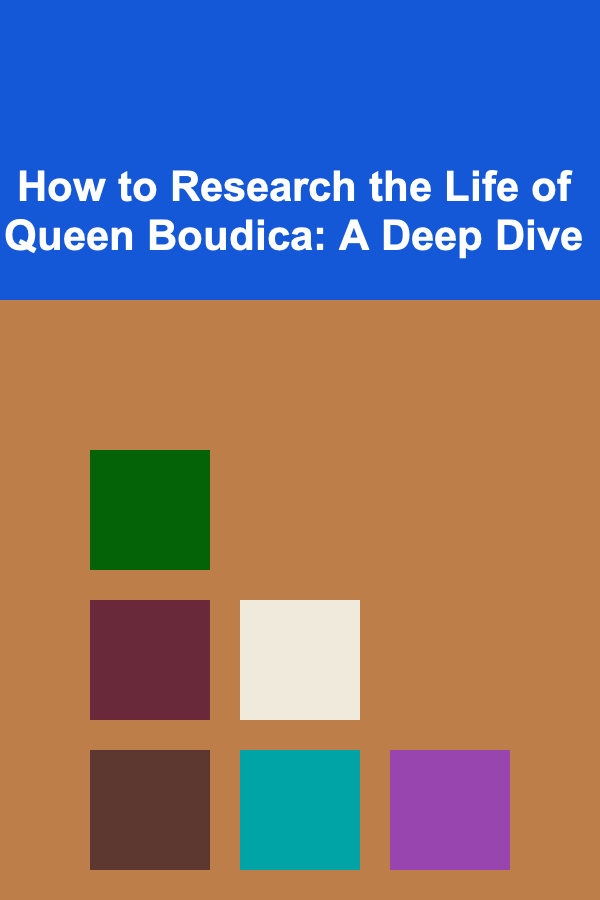
How to Research the Life of Queen Boudica: A Deep Dive
ebook include PDF & Audio bundle (Micro Guide)
$12.99$5.99
Limited Time Offer! Order within the next:

Boudica, the warrior queen of the Iceni tribe, remains a powerful and enigmatic figure in British history. Leading a fierce rebellion against the Roman occupation in AD 60/61, her story has been told and retold, embellished and reinterpreted, across centuries. Researching her life, therefore, requires careful navigation of sparse historical sources, archaeological evidence, and the ever-shifting sands of historical interpretation. This article provides a comprehensive guide to researching the life of Boudica, delving into the available sources, methodologies, and potential pitfalls that await the aspiring scholar.
Understanding the Challenges: The Limited Evidence and Its Interpretation
The primary challenge in researching Boudica lies in the limited and biased nature of the historical evidence. Our knowledge of her life and rebellion rests almost entirely on the accounts of two Roman historians: Tacitus and Cassius Dio. While invaluable, these accounts are not without their limitations:
- Roman Perspective: Both Tacitus and Dio were Romans, writing for a Roman audience. Their accounts are inevitably shaped by Roman perspectives on the Britons, Roman anxieties about rebellion, and the desire to portray Roman victory (or, in Tacitus' case, Roman shortcomings) in a particular light. Their descriptions may exaggerate the barbarity of the Britons or minimize the scale of Roman defeats.
- Secondary Accounts: Tacitus and Dio were not eyewitnesses to Boudica's rebellion. They relied on secondary sources, which may have been themselves influenced by rumour, propaganda, or inaccurate information. The chain of transmission introduces opportunities for distortion and embellishment.
- Missing Information: Neither Tacitus nor Dio provides a complete or unbiased picture of Boudica's life or the events surrounding the rebellion. Significant details are omitted, particularly regarding the motivations and perspectives of the Iceni and other British tribes. We know little about Boudica's early life, her family (beyond her husband Prasutagus and her daughters), or the specific grievances of the British population.
- Literary Devices: Both authors employed literary devices and rhetorical techniques to enhance their narratives. Dio, in particular, is prone to dramatic flourishes and moralizing pronouncements. It is crucial to distinguish between historical fact and literary embellishment when interpreting their accounts.
Acknowledging these limitations is the first step in responsible research. We must approach Tacitus and Dio as biased sources, critically evaluating their claims and seeking corroboration from other evidence where possible.
The Primary Sources: Tacitus and Cassius Dio
Our primary sources of information about Boudica are the works of Tacitus and Cassius Dio. Understanding the context and content of their writings is essential:
Tacitus: Annals and Agricola
Tacitus mentions Boudica in two of his works: the Annals and the Agricola. The Annals provide the most detailed account of the Boudican rebellion, focusing on the Roman perspective and the military campaigns. Agricola, a biography of his father-in-law, Gnaeus Julius Agricola, the Roman governor of Britain, also briefly mentions the rebellion and its lasting impact. Key aspects of Tacitus' account include:
- The Causes of the Rebellion: Tacitus attributes the rebellion to the rapacious behavior of Roman officials, particularly the financial exactions of Seneca, and the brutal treatment of Boudica and her daughters following the death of her husband, Prasutagus. This emphasizes Roman culpability and highlights the injustices suffered by the Iceni.
- The Course of the Rebellion: Tacitus describes the initial successes of the British forces, including the sack of Camulodunum (Colchester), Londinium (London), and Verulamium (St Albans). He details the widespread destruction and the heavy casualties inflicted on the Romans and their allies.
- The Battle of Watling Street: Tacitus provides an account of the decisive battle where the Roman forces, under the command of Suetonius Paulinus, decisively defeated the Britons. He emphasizes the superior Roman discipline and tactics that led to the British defeat.
- Boudica's Death: Tacitus states that Boudica poisoned herself to avoid capture. This act of defiance reinforces her image as a proud and unyielding warrior queen.
When studying Tacitus, it is crucial to consider his broader agenda. He was a senator and historian who was critical of the excesses of the Roman imperial system. His account of the Boudican rebellion can be seen as a cautionary tale, highlighting the dangers of misgovernance and the potential for unrest in the provinces.
Available translations of Tacitus are numerous. Michael Grant's translation of the Annals is widely accessible. For a more scholarly and nuanced translation, consider the Penguin Classics edition translated by A.J. Woodman.
Cassius Dio: Roman History
Cassius Dio, writing in the 3rd century AD, provides a somewhat different account of the Boudican rebellion in his Roman History. Dio's account is more fragmented and sensationalized than Tacitus', but it offers valuable insights into how the story of Boudica evolved over time. Key aspects of Dio's account include:
- Boudica's Appearance: Dio offers a vivid description of Boudica's physical appearance, emphasizing her height, her flowing red hair, and her piercing gaze. This image has contributed significantly to the popular perception of Boudica as a fearsome warrior queen.
- Boudica's Speech: Dio includes a speech attributed to Boudica, urging her followers to fight for their freedom. This speech, while likely a fictionalized account, provides valuable insight into the perceived motivations of the rebels and the grievances they held against the Romans.
- The Role of Gender: Dio emphasizes Boudica's gender, portraying her as an unusual and even unnatural leader. This reflects Roman anxieties about female authority and the perceived threat posed by a woman leading an army.
- Differing Details: Dio provides different details regarding the events of the rebellion, such as the number of casualties and the location of the final battle. These discrepancies highlight the challenges of reconstructing the historical record from fragmented and conflicting sources.
Dio's account is often considered less reliable than Tacitus' due to its later date and more sensationalized tone. However, it provides a valuable perspective on how the story of Boudica was interpreted and embellished over time. It also highlights aspects not covered by Tacitus, offering a broader view of the context of the rebellion.
Cary's translation of Cassius Dio in the Loeb Classical Library is a widely used and respected edition.
Archaeological Evidence: Complementing and Challenging the Written Record
Archaeological evidence can provide valuable insights into the Boudican rebellion, complementing and sometimes challenging the written accounts. Excavations at the sites of Camulodunum, Londinium, and Verulamium have uncovered evidence of widespread destruction and burning, consistent with the accounts of Tacitus and Dio. This evidence can help us to understand the scale and intensity of the rebellion. However, archaeological evidence must be carefully interpreted, as it is often fragmentary and open to multiple interpretations.
Key areas where archaeology contributes to our understanding of Boudica include:
- Destruction Layers: Layers of ash and burnt debris found in Colchester, London, and St Albans provide tangible evidence of the destruction wrought by the rebellion. The dating of these layers helps to confirm the chronology of events described by Tacitus and Dio.
- Roman Artifacts: The discovery of Roman artifacts, such as weapons, armor, and coins, provides insights into the Roman presence in Britain and the military capabilities of the Roman army. The distribution of these artifacts can help us to reconstruct the movements of Roman troops and the locations of key battles.
- British Settlements: Excavations of British settlements can shed light on the lives of the Iceni and other tribes who participated in the rebellion. These settlements provide evidence of their social structure, economic activities, and religious beliefs. Understanding the pre-Roman context is crucial for understanding the motivations behind the revolt.
- Burials: The discovery of mass graves and individual burials related to the period can offer insights into the casualties of the rebellion and the treatment of the dead. Analysis of skeletal remains can provide information about the health and diet of the British population.
Examples of relevant archaeological sites and findings include:
- Camulodunum (Colchester): Archaeological investigations have revealed evidence of the destruction of the Temple of Claudius and the Roman colonia, confirming the ferocity of the initial assault.
- Londinium (London): Excavations beneath modern London have uncovered layers of burnt debris dating to the period of the Boudican rebellion. These layers provide evidence of the widespread destruction of the Roman settlement.
- Verulamium (St Albans): The remains of the Roman city of Verulamium show evidence of burning and destruction, further supporting the historical accounts.
- Local Iceni Sites: Investigation of sites within the traditional Iceni territory, such as fortified settlements and burial grounds, can provide insight into the societal structures and military capabilities of the Iceni people prior to and during the rebellion.
To research archaeological evidence related to Boudica, consult archaeological reports, journals such as Britannia, and publications from organizations such as the British Museum and the Society of Antiquaries of London. Online databases, such as the Portable Antiquities Scheme, can also provide information about individual finds.
Secondary Sources: Navigating Historical Interpretations
A vast body of secondary literature exists on Boudica, ranging from scholarly monographs to popular biographies. These sources can provide valuable insights and interpretations, but it is crucial to approach them critically, recognizing that they are shaped by the authors' own perspectives and agendas. Consider the following when evaluating secondary sources:
- Author's Perspective: Consider the author's background, expertise, and potential biases. Are they a historian, archaeologist, or novelist? What is their particular area of interest or specialization? How might their perspective influence their interpretation of the evidence?
- Use of Evidence: Assess how the author uses primary and secondary sources. Do they rely heavily on Tacitus and Dio, or do they incorporate archaeological evidence and other sources? Do they critically evaluate the evidence, or do they accept it uncritically?
- Interpretations and Arguments: Evaluate the author's interpretations and arguments. Are they well-supported by evidence? Are they consistent with other historical knowledge? Do they consider alternative perspectives or explanations?
- Date of Publication: Consider the date of publication. Historical interpretations can change over time as new evidence emerges and new perspectives are adopted. Older publications may reflect outdated understandings of the evidence.
Some notable secondary sources on Boudica include:
- Peter Salway, Roman Britain (Oxford University Press): Provides a comprehensive overview of Roman Britain, including a detailed discussion of the Boudican rebellion.
- Graham Webster, Boudica: The British Revolt Against Rome AD 60 (Routledge): A classic study of the Boudican rebellion, offering a detailed analysis of the historical sources and archaeological evidence.
- Vanessa Collingridge, Boudica (Ebury Press): A more recent biography of Boudica, exploring her life and legacy.
- Miranda Aldhouse-Green, Boudica (Ladybird Expert Series): A concise and accessible introduction to Boudica and the rebellion.
When researching Boudica, it is essential to consult a range of secondary sources, representing different perspectives and interpretations. This will allow you to develop a more nuanced and comprehensive understanding of her life and the events surrounding the rebellion.
Beyond Traditional Sources: Exploring Cultural Representations and Reinterpretations
The story of Boudica has resonated throughout history and continues to inspire artists, writers, and filmmakers. Exploring cultural representations and reinterpretations of Boudica can provide valuable insights into how her legacy has been shaped and how her story continues to be relevant today. Consider the following:
- Literature: Boudica has been the subject of numerous novels, poems, and plays, each offering a different interpretation of her life and motivations. These literary works can reveal how her story has been used to explore themes of resistance, freedom, and national identity. Examples include Geoffrey of Monmouth's fictionalized account in History of the Kings of Britain and more modern interpretations.
- Art: Boudica has been depicted in various works of art, from Roman sculptures to Victorian paintings. These artistic representations often reflect the prevailing attitudes and values of the time in which they were created. Consider, for instance, the famous statue of Boudica in London, which portrays her as a powerful and defiant warrior queen.
- Film and Television: Boudica has been portrayed in several films and television series, often in highly dramatized and romanticized ways. These portrayals can reinforce popular perceptions of her as a heroic figure, but they can also distort the historical record.
- Modern Interpretations: Boudica continues to be a source of inspiration for feminist and nationalist movements. Her story is often used to symbolize female empowerment, resistance to oppression, and the struggle for national independence.
By examining these cultural representations, you can gain a deeper understanding of the complex and evolving legacy of Boudica.
Key Research Questions to Consider
When researching the life of Boudica, consider exploring the following research questions:
- What were the primary causes of the Boudican rebellion, and how did Roman policies contribute to the unrest?
- What were Boudica's motivations for leading the rebellion, and how did she rally support from other British tribes?
- What were the key events of the rebellion, and how did the British forces manage to achieve their initial successes?
- What were the strengths and weaknesses of the Roman military, and how did they ultimately defeat the Britons?
- What impact did the rebellion have on Roman Britain, and how did it shape Roman policies towards the Britons in the long term?
- How has Boudica's story been interpreted and reinterpreted throughout history, and what does this tell us about changing attitudes towards gender, power, and resistance?
- To what extent can we trust the accounts of Tacitus and Cassius Dio, and how can we corroborate their claims with archaeological evidence?
- What can archaeological evidence tell us about the lives of the Iceni and other British tribes who participated in the rebellion?
- How accurate are popular depictions of Boudica in literature, art, and film, and how do they contribute to our understanding of her legacy?
- What is Boudica's significance in modern society, and how is her story used to inspire and empower people today?
Conclusion: A Continuing Quest for Understanding
Researching the life of Queen Boudica is a challenging but rewarding endeavor. By critically examining the available sources, considering different perspectives, and exploring cultural representations, we can gain a deeper understanding of this complex and fascinating figure. While the historical record remains incomplete, the story of Boudica continues to resonate, reminding us of the power of resistance and the enduring struggle for freedom. The quest to understand Boudica is an ongoing process, requiring a commitment to rigorous research, critical thinking, and a willingness to engage with the complexities of the past.

Best Organization Tools for Social Media Management
Read More
How to Create a Minimalist Toy Collection
Read More
How to Let ChatGPT Help You Learn Physics
Read More
How to Tackle Pet Hair Cleanup in Your Home
Read More
How To Learn Mobile Game Development
Read More
How To Build a Powerful Personal Brand
Read MoreOther Products

Best Organization Tools for Social Media Management
Read More
How to Create a Minimalist Toy Collection
Read More
How to Let ChatGPT Help You Learn Physics
Read More
How to Tackle Pet Hair Cleanup in Your Home
Read More
How To Learn Mobile Game Development
Read More